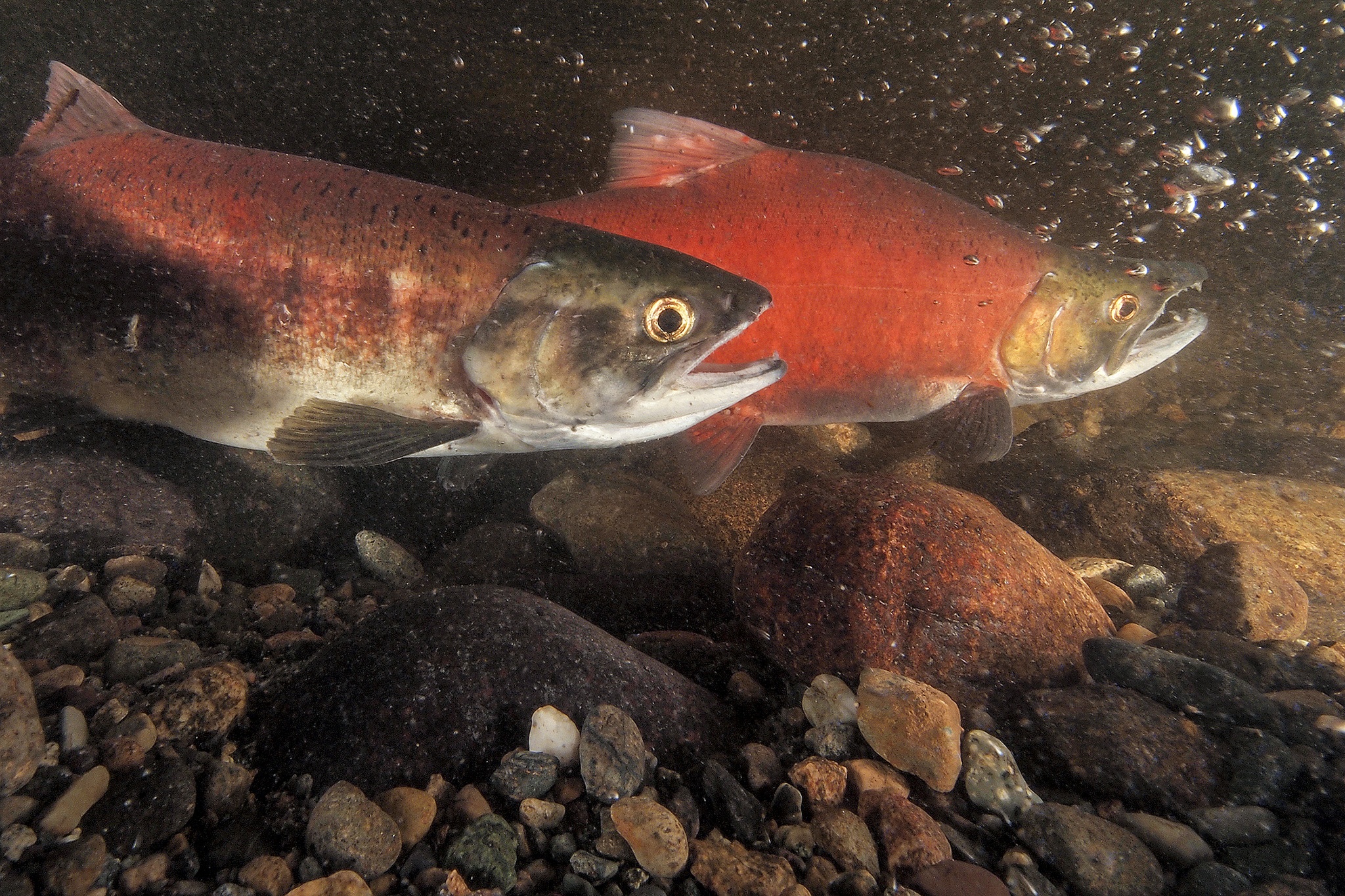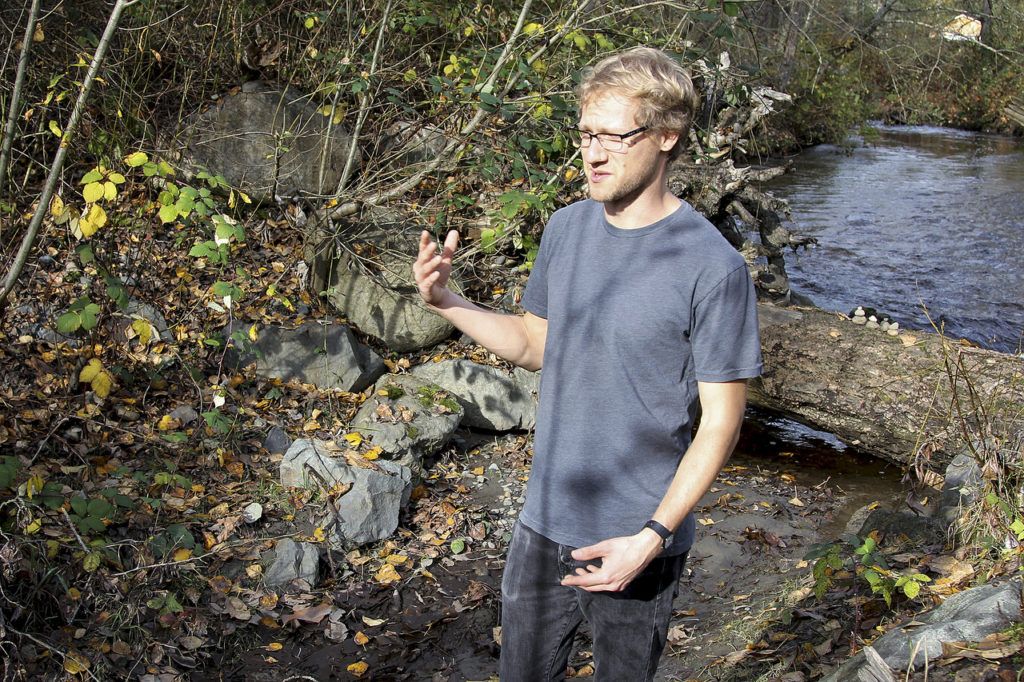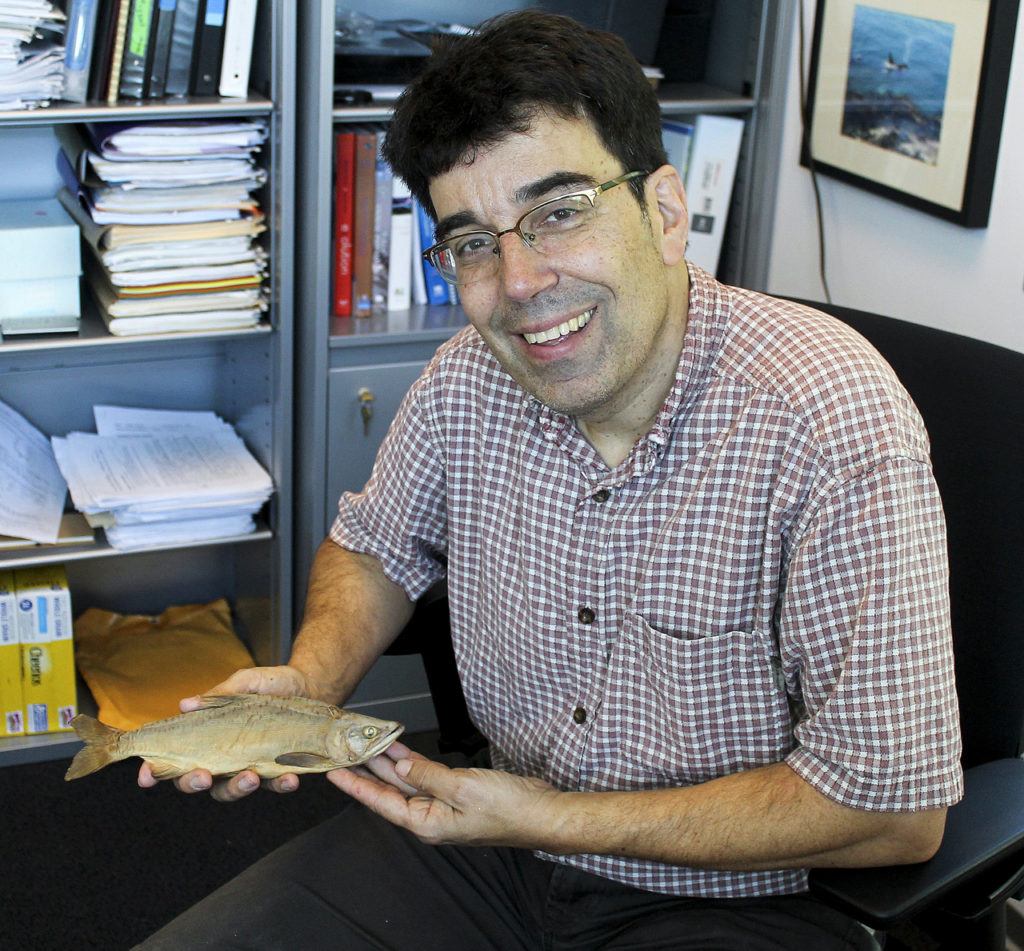By Celeste Gracey
Bothell-Kenmore Reporter
BOTHELL — The student braced himself with a branch, as he slid his worn sneakers across the top of a log jam.
Swamp Creek pooled below him on one side, and on the other it skated, spinning and arching around gravel and debris caught up on the toppled tree.
The disturbance was perfect for kokanee salmon, said Scott Miller, a biology major at the University of Washington’s Bothell campus, while surveying the little creek. The jam slows the pace of the river and provides inlets for reprieve from the current.
Each fall a century ago, the creek was painted with the “little red fish,” which came from their home in north Lake Washington to spawn in numbers that still impress today’s biologists.
Now, those same scientists debate whether or not the Lake Washington kokanee have gone extinct.
“There’s a profound sense of loss,” said Jim Mattila, a fisheries scientist and a sort of community historian when it comes to north Lake Washington streams. “Society is missing what (the kokanee) meant.”
While efforts to save Lake Sammamish kokanee have gained significant ground in the past decade, the interest in Lake Washington has just hatched. The incubator of this effort is Dr. Jeff Jensen, who earned a doctorate from Harvard in organismic and evolutionary biology and is University of Washington Bothell’s resident “fish guy.”
No one knows for sure what depleted the kokanee population in the 1920s and again in the 1970s, Jensen said. It could be a mixture of anything from development, raw sewage spilling into the lake or the building of the Ballard Locks.
Jensen is optimistic that the kokanee are still around, and he’s using the students in his Salmon and Society course to find them.
“It’s kind of like chasing a unicorn,” he said, adding that they’re rare but there is evidence that the kokanee have survived.
Snohomish County creeks
For decades, people have focused on restoring the runs for the region’s large sea-going fish, such as chinook and steelhead. What it has missed is that historic records show that the kokanee were once the dominant fish to run in Lake Washington creeks.
Their presence was so supreme, records dating back to the 19th century don’t mention the larger fish. Researchers can’t even confirm that steelhead or chinook were in Lake Washington until after engineers rerouted the Cedar River into the lake to fuel the Ballard Locks during the 1910s.
That has given rise to a belief that kokanee were also once the only salmon species to populate Lake Washington, and when it comes to restoring the natural biology, government agencies should be focused on kokanee.
This is at least Jensen’s thought, cautiously adding that kokanee have directly benefited from restoration projects aimed at larger species.
Since returning to Washington in 2012, he’s grown fascinated with North Creek, which runs through UW’s Bothell campus and south Snohomish County all the way up to Everett. Swamp Creek also has its headwaters in Everett, and drains much of suburban south Snohomish County.
Muddy boots
In class, Jensen wears a loose, short-sleeved button down that conceals a comedic Darwin T-shirt. His brown leather shoes are better suited for walking river trails than polishing. He lectures with large expressions, occasionally slipping in humor so seamlessly he doesn’t give himself a chance to crack a smile.
His salmon course puts students on the ground at hatcheries and restoration projects, where they meet professionals working on solutions, before going to do their own research.
After leaving class with muddy, wet feet three weeks in a row, biology major Jim Solberg realized boots were never really optional, he said. “I like how he’s just throwing us out there.”
To Jensen, the loss of kokanee is striking.
He split his class into four groups, each tasked with writing restoration plans for a different creek — Swamp, Little Bear, Lyon and McAleer — ones typically deemed too small to support meaningful populations of bigger salmon. He hopes the reports will someday be a useful tool.
Miller’s team visited Swamp Creek a couple times a week, occasionally talking to locals about kokanee along the way. At the shore, the three students inspected gravel for silt, which can suffocate eggs, and noted how the creek has changed after a heavy rain. They became familiar with its intricacies.
As a child, Mattila remembers walking along Swamp Creek in the summer and seeing fishing gear and other signs that children had been playing along the shore. When he returned as an adult, he realized his own footprints were the only evidence of people. The community’s lost connection with nature saddens him.
Creekside residents are not only important for finding evidence of kokanee, but they play the largest part in making the streams healthy enough to support a strong run. While most efforts to help larger salmon are beneficial to kokanee, their restoration differs in the focus on smaller creeks, which cities have often treated like storm drains.
“A lot of those streams have been written off,” said Jim Myers, a NOAA biologist and Bothell local, adding that he’s glad Jensen is calling attention to the little red fish. Myers follows the kokanee, because of how closely they interact with sockeye.
Runoff from impervious surfaces, such as rooftops and parking lots, rushes toward creeks, instead of soaking into the ground. After a storm, the additional rush of water stirs up gravel that the salmon eggs find shelter beneath, and pushes it downstream like a “conveyor belt,” Mattila said.
While extra runoff is also an issue for larger salmon, one major storm can devastate kokanee, who don’t bury their eggs as deep. Add a tight culvert, a large pipe that directs water under roads, and the pressure is like a fire hose. The kokanee couldn’t even swim through. While replacing culverts with bridges is ideal, even larger culverts can open a run again, said David St. John, chairman of the Kokanee Work Group, which is focused on restoring Lake Sammamish kokanee.
DNA proof
Balancing an unassuming brown package atop a waterproof sack full of student homework, Jensen fumbled for the keys to his office. It was obvious his ear-to-ear grin wasn’t for the impending interview. He slit the box open and removed a few preserved salmon, wrapped in gauze, sealed in plastic and dated from the year 1888.
In the century that the Smithsonian has stored these Lake Washington kokanee, they’ve lost the telling color that earned them the title “our little red fish.” Pushing aside his keyboard, Jensen unwrapped a fish. Alcohol, used in their preservation, dripped to the floor. The kokanee smelled oddly sweet and not at all like fish.
If a kokanee-looking salmon is found in a Lake Washington stream, the 130-year-old DNA sample could help distinguish whether they were related to the original kokanee or to more recently introduced populations. Jensen also is taking CT scans to compare the anatomy to current populations. Little differences in gill rakers can speak to the fish’s history.
The samples also have the potential to shed light on the residual sockeye theory.
Sockeye and kokanee are similar enough that they can interbreed. Although sockeye are much larger, occasionally they’re small enough to be confused for kokanee. If that isn’t confusing enough, there are small sockeye that don’t go to the sea, either. They’re called residual sockeye.
These residual sockeye would explain why people have been seeing little red fish in streams where the kokanee are believed to be extinct. So far, all of the kokanee look-alike samples found outside of Lake Sammamish don’t have the same genetic markers as fish known to be kokanee.
The residual sockeye theory still doesn’t sit well with Jensen, because the sightings are coming in December and January, long after sockeye runs finish. However, there isn’t historical evidence for Lake Washington kokanee running late, either. That characteristic is reserved for the Sammamish kokanee, and so conjecture takes another turn. What if those fish are from neighboring Lake Sammamish?
Jensen plans to compare his 130-year-old fish to today’s Sammamish kokanee. As intriguing as the differences could be, no difference would be the most astounding result. It would reduce hesitation to reseed the Lake Washington streams with Sammamish kokanee.
The ultimate proof of what little red fish are running in Swamp or North creeks will come when people start turning up samples.
“Everyone can have their pet theories, and that’s fine. I always like to wait to see what the data is,” said Myers, the NOAA biologist. “At this point, anything is possible… Hopefully this year or next we may actually get some evidence, so we can test all of those different theories.”
Celeste Gracey is a former Sound Publishing reporter and currently a student at the University of Washington Bothell.
Spot a kokanee?
Submit reports to Jeff Jensen through this site, https://lfpsf.org/salmon-sightings-reporting
For samples, dead or alive, put it in your freezer and email uwbkokanee@gmail.com
Talk to us
> Give us your news tips.
> Send us a letter to the editor.
> More Herald contact information.



























